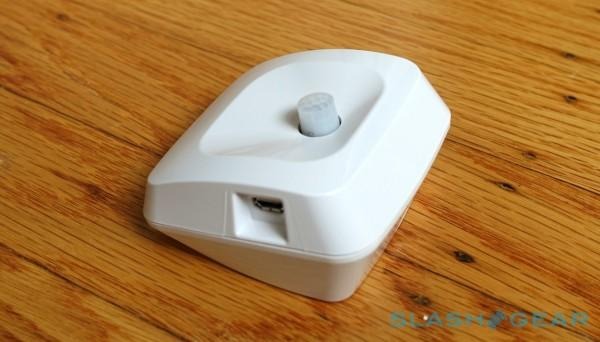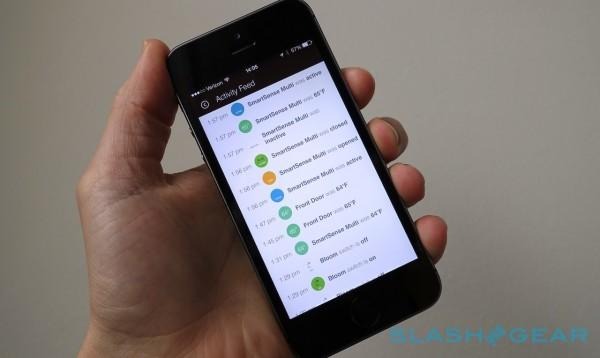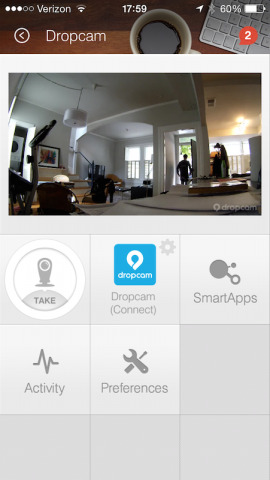My Smart Home Trolled Me
"Motion near upstairs," the notification says. That's upstairs in my apartment, the place I was around 2,800 miles away from; on the other side of the country from, in fact. It's Saturday morning, I'm away for the weekend, and SmartThings is being terribly helpful in notifying me that one of its motion detectors has spotted something unusual. That's when I start to panic.
I've been a vocal supporter of smart home and home automation technologies for some time now. For the past year, I've been sharing living space with both SmartThings and Revolv. My lamps have been Philips hue-enabled pretty much since the color-changing bulbs first went on sale.
From my smartphone I can see who's home and who's away, whether doors are open, and what temperature it is. I can adjust the music, and the lights, and even shut off the crockpot all from apps – or, I can let the whole setup adjust itself, leaving it to switch things on and off around me.
I'd gotten complacent, then, and it had come back to bite me.

SmartThings keeps logs of all the recent activity from each component, so I first trawled through there to see if I could figure out the path an intruder might have taken. The fact that there was only one blip of motion detected by that sensor pointed to it being a false alarm, but to be sure I really needed to know if they'd tripped something elsewhere in the apartment.
That's when the problems really started. Upstairs I have SmartThings' own motion sensor, which has been pretty reliable bar some low-power glitches when I first turned it on. Switching out the batteries fixed that, though.
Downstairs, however, I've got a Belkin WeMo motion sensor, which is also supported by SmartThings, but which at times decides it's not going to register. That means no logging, which means I had no idea if it had been triggered too. The light plugged into the companion WeMo remote socket should've turned on if the motion sensor was activated, but that's proved reluctant to log too, if it's not being controlled by a SmartThings trigger.
Of course, what I didn't have was a camera, so that I could actually see what was going on.

I flipped between panicked – imagining everything of value being gone when I got back the following day – and succumbing to my own self reassurance. The front door hadn't been opened, at least according to SmartThings, which was a vote in the right direction. On the flip side, there's a fairly large window that I hadn't bothered putting a sensor on, figuring that anybody opening it would simply trip the WeMo motion sensor.
Eventually I argued myself into thinking it was all just a mistake, though I wasn't quite convinced until I walked back through the door late on Sunday evening.
Now, I should make it clear that I'm not blaming SmartThings for this. Nor am I blaming Belkin. I've nobody to blame but myself, in fact, and that's for not properly thinking through what I was installing, when I was installing it.
I did what I think many people do when they piece together a DIY security or automation system: think in broad strokes, and try to maximize the scope of the few components they have on hand. Considering only as far as the first stage of a break-in – someone actually being inside my apartment – I relied on a single level of warnings with motion sensors upstairs and downstairs, and a door sensor on the front door.

What I hadn't given any thought to was what came next: the icy grip on your chest when you see the "Intruder Alert!" notification on your phone, and instantly try to diagnose exactly what has happened. If I'd thought that through properly, I would've figured out some of the things I might be curious about when in that state of mind – what door or window did they come in through, by what route did they move through the house and exit, and did they take anything with them when they left? – and planned ahead with the right components.
I'd also have made sure all of the different services and platforms were talking to each other properly, as well as being logged. The initial movement alert came in at 2:39am, when I was – unsurprisingly – asleep; looking at the real-time status of each of the sensors when I was finally awake, several hours later, was no use to me.
My other conclusion was that, even if you're happy fitting a DIY system and controlling everything yourself from your phone, you need to have some sort of follow-up plan in place. Who are you going to call when you're on the other side of a continent and staring at an alert notice that may or may not be a false-positive? Do you have their number saved in your phone? Do they have spare keys to get inside?
As a result I've gained a new degree of respect for monitored systems like Vivint's Sky which, though comparatively expensive, do at least have the reassurance of a 24/7 call center to act on any alarms that might get triggered.
It was an uncomfortable way to learn a lesson, but an important one. I've put more door and window sensors in now, meaning that even if the motion detection glitches or simply stops working, the security system has another layer of awareness around the most obvious points of entry.

Meanwhile, I also invested in a camera, opting for a Dropcam Pro which is a SlashGear favorite and is regularly praised for its easy setup, picture quality, and overall stability.
Before, I might have been tempted by something cheaper with a few more rough edges, but memories of components not talking to each other when I was too far away to troubleshoot swayed my hand to the Dropcam option.
SmartThings also has Dropcam integration as part of its experimental "Labs" program.
While I can access the stream through the camera's dedicated app, through SmartThings I can have it triggered by other activity, like doors opening or movement detected, and even trigger lights and sirens as a result. I'm expecting something similar to be added for Samsung's Dropcam rival, what with the acquisition, but I wasn't willing to wait for that to happen.
My apartment isn't a fortress. Everything extra I've added is passive, rather than bars on the window or a large, hungry dog. If someone really wants to break in, they're more than likely going to figure out a way to do that.
What it gives me, though, is a little extra peace of mind: the likelihood of me being burgled is relatively low, whereas the probability of me getting paranoid after an erroneous alert is very high. If you're installing your own smart home system, no matter the platform, it's a good reminder that you need to think about more than just whiz-bang color changing lights that turn on when you walk through the door.
For more on SmartThings, check out our full review!
